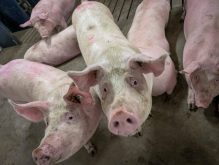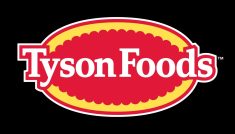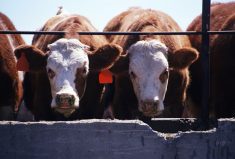In a decision that may have come late for some, New Brunswick, Prince Edward Island and parts of southeastern Quebec and northwestern Nova Scotia have been declared drought zones for eligible livestock producers’ 2020 tax purposes.
The federal government on Monday released its list and map of prescribed drought regions where tax deferral on sales of breeding livestock has been authorized for the 2020 tax year.
In regions officially designated for drought, flood or excess moisture, the tax deferral provision allows eligible producers who reduced their breeding herds by at least 15 per cent to defer part of their 2020 income from sales until their next non-designated tax year.
Read Also

U.S. livestock: Cattle strengthen Tuesday
Cattle futures on the Chicago Mercantile Exchange were stronger on Tuesday, with cold temperatures hitting the northern U.S. Plains and…
To defer income, a producer’s breeding herd must have been reduced by at least 15 per cent. If the herd was cut by at least 15 per cent, but less than 30 per cent, then 30 per cent of income from net sales can be deferred. Where a producer reduced a breeding herd by 30 per cent or more, 90 per cent of income from net sales can be deferred.
In the 2021 tax year — or the next tax year in which the designation is lifted for a specific region — the income from those sales can be at least partially offset by the cost of reacquiring breeding animals, “thus reducing the potential tax burden,” the government said.
Along with all of New Brunswick and Prince Edward Island, the drought-designated regions include 82 census subdivisions in southeastern Quebec’s Gaspesie and Bas-Saint-Laurent regions, plus the Cumberland census subdivisions A, B, C and D and Colchester subdivision A in northwestern Nova Scotia.
In those regions last year, “low moisture levels resulted in significant forage shortages for livestock producers,” the government said, and reducing breeding herds so as to manage feed supplies was one available option.
The Canadian Cattlemen’s Association said Tuesday it appreciates the designations, but noted that with the 2020 individual tax year payment deadline of April 30, 2021 already passed, “eligible producers may need to take additional steps to utilize the deferral.”
For example, the CCA said, producers who’ve yet to file a self-employed farming income 2020 tax return have until June 15 this year to account for the deferral provisions.
If an eligible producer want to defer such income but already filed a return for 2020, the CCA recommends producers talk to a tax professional about filing a 2020 tax return adjustment.
In its statement, the CCA also said its position is still that “considerable amendments to the provision are needed to make it a more functional risk management tool for cattle producers.”
For example, the association said, the provision could be set up so producers could use it “through individual election rather than a geographic determination.”
That way, the provision doesn’t run the risk of “delayed announcements” or excluding access for affected producers who fall outside a designated area’s exact boundary lines. The CCA said it would also like to see all classes of cattle eligible under the deferral provision.
The CCA noted the House of Commons’ standing committee on agriculture and agri-food, in a report last fall on business risk management programs, recommended the federal government work with farm groups on a “comprehensive review” of the deferral provision. — Glacier FarmMedia Network

















